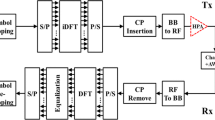Abstract
A new class of time domain second order polynomial Nyquist window functions is proposed and applied to orthogonal frequency division multiplexing (OFDM) systems for reducing frequency offset induced inter-carrier interference (ICI) at the receiver. The signal to ICI plus noise ratio (SINR) of the receiver is analyzed in this paper. We also propose a method to select the window parameters to maximize the SINR of the receiver thus providing optimal performance. The receiving method with optimal second order polynomial window is shown to provide performance better than raised cosine and “better than” Nyquist window.
Similar content being viewed by others
References
Jamalipour A., Wada T., Yamazato T. (2005) A tutorial on multiple access technologies for beyond 3G mobile networks. IEEE Communications Magazine 43: 110–117
Sternad M., Svensson T., Ottosson T., Ahlen A., Svensson A., Brunstrom A. (2007) Toward systems beyond 3G based on adaptive OFDMA transmission. Proceedings of the IEEE 95: 2432–2455
Pollet T., Van Bladel M., Moeneclaey M. (1995) BER sensitivity of OFDM systems to carrier frequency offset and Wiener pahse noise. IEEE Transactions on Communications 43: 191–193
Steendam H., Moeneclaey M. (2000) Sensitivity of orthogonal frequency division multiplexed systems to carrier and clock synchronization errors. Signal Processing 80: 1217–1229
Rugini L., Banelli P. (2005) BER of OFDM systems impaired by carrier frequency offset in multipath fading channels. IEEE Transactions on Wireless Communications 4: 2279–2288
Ma, X., Kobayashi, H., & Schwartz, S. C. (2003). Effect of frequency offset on BER of OFDM and single carrier systems. In Proceedings of the IEEE PIMRC China, 2239–2243.
Ahn J., Lee H. S. (1993) Frequency domain equalization of OFDM signal over frequency nonselective Rayleigh fading channels. Electronics Letters 29: 1476–1477
Al-Dhahir N., Cioffi J. M. (1996) Optimum finite-length equalization for multicarrier transceivers. IEEE Transactions on Communications 44: 56–64
Wu H. C., Huang X. Z., Wu Y. Y., Wang X. B. (2008) Theoretical studies and efficient algorithm of semi-blind ICI equalization for OFDM. IEEE Transactions on Wireless Communications 7: 3791–3798
Zhao Y., Haggman S. G. (2001) Intercarrier interference self-cancellation scheme for OFDM mobile communication systems. IEEE Transactions on Communications 49: 1185–1191
Zhao, Y., & Haggman, S. G. (1997). A general coding method to minimize intercarrier interference in OFDM mobile communication systems. In Proceedings of the IWTS, 231–235.
Wang, Y., & Huang, Z. Y. (2009). Error probability analysis of OFDM systems with ICI self-cancellation over AWGN and Rayleigh flat-fading channels. In Proceedings of the APCC, 798–802.
Muschallik C. (1996) Improving an OFDM reception using an adaptive Nyquitst windowing. IEEE Transactions on Consumer Electronics 42: 259–269
Muller-Weinfurtner S. H. (2001) Optimum Nyquist windowing in OFDM receivers. IEEE Transactions on Communications 49: 417–420
Bottomley G. E., Wilhelmsson L. R. (2008) Recovering signal energy from the cyclic prefix in OFDM. IEEE Transactions on Vehicular Technology 57: 3205–3211
Dai K., Song R. F. (2007) An improved anti-frequency-offset method by windowing in OFDM systems. Journal of Electronics & Information Technology 29: 1916–1918
Beaulieu N. C., Tan P. (2007) On the effects of receiver windowing on OFDM performance in the presence of carrier frequency offset. IEEE Transactions on Wireless Communications 6: 202–209
Beaulieu, N. C., & Tan, P. (2005). Receiver windowing for reduction of ICI on OFDM systems with carrier frequency offset. In Proceedings of the IEEE GLOBECOM, 2680–2684.
Tan P., Beaulieu N. C. (2009) Analysis of the effects of Nyquist pulse-shaping on the performance of OFDM. European Transactions on Telecommunications 20: 9–22
Tan P., Beaulieu N. C. (2004) Reduced ICI in OFDM systems using the “better than” raised cosine pulse. IEEE Communications Letters 8: 135–137
Beaulieu N. C., Tan C. C., Damen M. O. (2001) A “better than” Nyquist pulse. IEEE Communications Letters 5: 367–368
Song R. F., Leung S. H. (2007) Second order polynomial class of chip waveforms for band-limited DS-CDMA systems. Wireless Personal Communications 43: 655–663
Author information
Authors and Affiliations
Corresponding author
Rights and permissions
About this article
Cite this article
Song, R., Guo, X. & Leung, S.H. Optimum Second Order Polynomial Nyquist Windows for Reduction of ICI in OFDM Systems. Wireless Pers Commun 65, 455–467 (2012). https://doi.org/10.1007/s11277-011-0267-x
Published:
Issue Date:
DOI: https://doi.org/10.1007/s11277-011-0267-x




